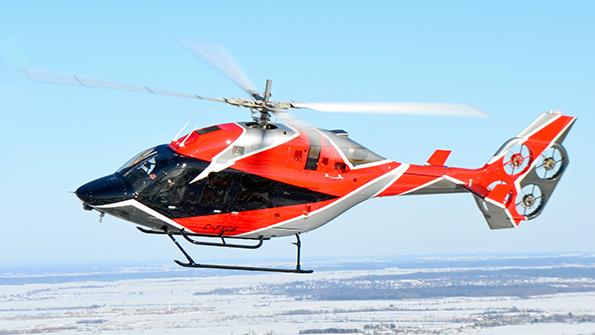
Bell is pondering how to incorporate advanced technologies developed for its future military platforms into its commercial rotorcraft.
Since its rebranding as more of a technology company than a helicopter OEM, CEO Mitch Snyder has been pushing the company on a course of innovation, investing in autonomous flight and electric propulsion as well as advancing defense capabilities.
- Bell hopes to certify fly-by-wire 525 in 2021
- EDAT electric anti-torque system will feature in a commercial product
But there appears to be little obvious gain for Bell’s line of civil rotorcraft. In the last couple of years, its commercial helicopters have received only fairly minor upgrades. The Model 407GXi light single-engine platform had its avionics upgraded so that it can fly under instrument flight rules, while the Model 412 medium twin received new avionics and uprated power. Yet both upgrades were essentially spun off from modifications for military programs.
The 407 update was developed for the U.S. Navy’s rotary-wing trainer requirement, which Bell lost to Leonardo, and the 412EPi was born from the type’s selection by Japan for its UH-X military utility requirement.
Bell’s restraint in further developing commercial rotorcraft likely is due to its prolonged effort to bring the new Model 525 to market. Nor is it a great time to bring a new aircraft to market. Sales remain stubbornly slow in the aftermath of a fall in energy prices that dramatically reduced orders from the lucrative oil-and-gas support market.
Progress in bringing the fly-by-wire, 9.3-metric-ton 525 super-medium to market—it was launched in 2012 and flown for the first time in 2015—has been painfully slow, in part due to the fatal loss of one prototype but also due to the need to convince certification authorities of fly-by-wire technology benefits. “The hurdle is higher now to try and get [the 525] certified,” Snyder told Aviation Week during a virtual roundtable on Oct. 19.
“This technology brings all these benefits and makes the aircraft safer. . . . You have to walk them through and give them time to understand it,” he said.
Snyder believes things are on track. “We feel very good about getting certified in 2021,” he added, noting that the company is finishing up testing and preparing for the submission of certification documentation to the FAA. He said Bell is continuing to evaluate new commercial platforms, although the cost of development and certification is prohibitive.
“We’re always looking to see if there’s a clean-sheet out there that we may want to do,” he said. “But I can tell you, at least right now, our focus has been around derivatives to our military products and more about adapting upgrades to our existing models.”
The approach appears to be in line with his views at last year’s Paris Air Show, where he suggested Bell may not develop a new clean-sheet commercial conventional rotorcraft beyond the 525.
One area of opportunity could be development of a single-engine medium helicopter, he hinted, building on Bell’s Model 360 Invictus prototype for the U.S. Army’s Future Attack Reconnaissance Aircraft (FARA) requirement.
“Bell’s got a lot of single-mediums out there,” said Snyder, noting that hundreds of Model 204/205 Iroquois helicopters remain in service with militaries, civilian operators and government agencies. Operators have become reliant on twin-engine helicopters, particularly because in some parts of the world, notably Europe, single-engine rotorcraft are banned from flying over urban areas. But Snyder said the 360 Invictus also features a supplemental power unit that can act as an auxiliary power unit as well as provide additional performance or auto-rotation power, and could be an enabler for a single-engine medium.
It is possible that Bell is looking at a military utility variant of the 360 Invictus, pairing the aircraft with the attack version in the same way that its UH-1Y Venom and AH-1Z Viper platforms have built on the Huey and Cobra. Such a platform could receive interest from the U.S. special operations community, which is looking to replace the Boeing AH-6/MH-6 Little Bird family. Officials have noted that they would like to be able to adapt a FARA platform to carry troops. Sikorsky’s Raider X can do so, but the Bell FARA cannot, until a more utilitarian version emerges (AW&ST June 1-14, p. 28).
The Army’s selection of Bell’s V-280 tiltrotor as the larger Future Long-Range Assault Aircraft could enable a commercial spinoff of the platform, Snyder suggests.
Bell is also looking to make commercial use of its Electrically Distributed Anti-Torque (EDAT) technology, a ducted electric tailrotor system tested on a Bell 429 light-twin. Flight tests for it were only revealed in February, despite the aircraft’s flights in plain sight from its Mirabel, Quebec, facility since May 2019. Testing showed that the EDAT reduced noise levels, but there were also benefits in terms of safety, enabling the option of switching off the anti-torque system while the engines and main rotor are still turning. The EDAT eliminates complex tailrotor gearboxes and shafts and requires less costly inspections and maintenance as well.
“We pulled in off-the-shelf technologies to make the demo occur within one year,” said Snyder. “Now we’re evaluating what the real technology needs to be as far as repackaging it in the weight and size that we require.”
Snyder said the EDAT technology will be aimed at a commercial rotorcraft, but for which product line or when it might be commercially available has yet to be decided.
